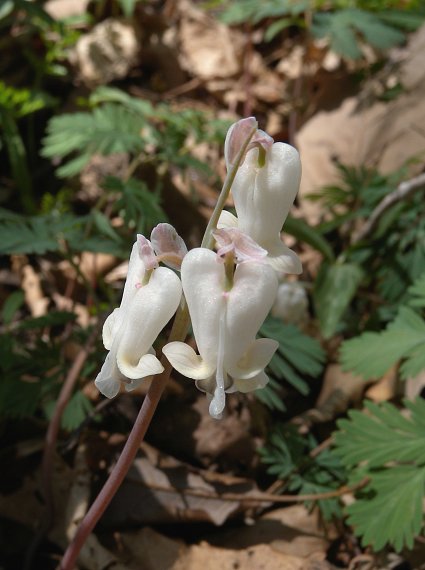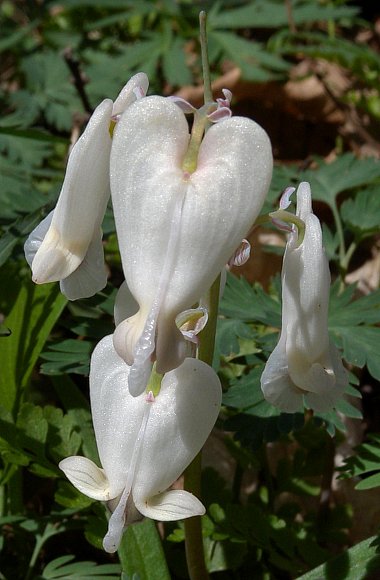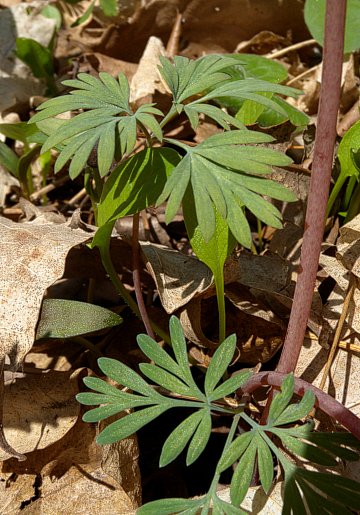
An inflorescence consisting of a raceme of flowers sometimes develops shortly after the formation of basal leaves. This inflorescence is 6-12" tall and it is either erect or ascending. The peduncle (basal stalk) of the inflorescence is pale red or pale yellowish green, terete, glabrous, and glaucous. Each raceme has 3-10 pendant flowers. The corolla of the pendant flower is ½–¾" long, mostly white, narrowly obcordoid in shape, and somewhat flattened. Two fused outer petals form the rounded nectar spurs (above), the lateral sides, and the pair of of upturned lips (below) of the corolla. Two fused inner petals form a pair of transverse crests and a pair of small inner claws near the entrance of the corolla. The small lips are shaped like keeled hoods with translucent parallel veins. The flat crests are half-cordate in shape, slightly wrinkled, slightly undulate, and white; sometimes they are pinkish along their bases. Inserted within the corolla is a pistil with a single style and several stamens. There are also a pair of tiny sepals; they are about 2-3 mm. long, linear-lanceolate in shape, and light pink with whitish margins. The nodding pedicels of the flowers are pale green or pale reddish green, terete, glabrous, and sometimes glaucous; they are up to ¼" long. At the bases of these pedicels, there are solitary floral bracts about 3-5 mm. long; they are ovate to obovate in shape and light pink with whitish margins.

The blooming period occurs during mid-spring for about 2-3 weeks. The flowers have a sweet fragrance. Afterwards, fertile flowers are replaced by drooping seed capsules that become about 12 mm. (½") long at maturity; these capsules are ovoid in shape and somewhat flattened. Each capsule divides into 2 parts to release its seeds; there are several seeds per capsule. The seeds are 1-2 mm. long, short-reniform in shape, and obscurely reticulate; each seed has an attached elaiosome (food appendage). The foliage dies down by mid-summer. The root system consists of a cluster of yellow globoid corms and fibrous roots.
Cultivation: The preference is dappled sunlight to medium shade, mesic conditions, and a loose loamy soil with decaying organic matter. Growth and development occur during the spring. Germination of the seeds can be slow and difficult, although it may be possible to start new plants by separating some of the corms. Insects and disease organisms are rarely troublesome.

Range & Habitat: The native Squirrel Corn occurs primarily in NE, east-central, and the southern tip of Illinois, where it is uncommon (see Distribution Map). Illinois lies toward the western range limit of this species; it is more common further to the east. Habitats include mesic deciduous woodlands, wooded bluffs, wooded slopes, ravines, and shaded stream banks. Squirrel Corn is found in high quality woodlands in Illinois, where the native ground flora is intact. It is one of the spring wildflowers that is threatened by the invasion of Garlic Mustard (Alliaria petiolata) and some Eurasian shrubs, particularly Amur Honeysuckle (Lonicera maackii).
Faunal Associations: The flowers are cross-pollinated primarily by queen bumblebees. Both nectar and pollen are available as floral rewards. The seeds are distributed to some extent by ants because of their elaisomes (food appendages). Because the foliage is toxic, it is usually avoided by mammalian herbivores. The overall value of this plant to faunal wildlife is low.

Photographic Location: A deciduous woodland at Jim Smith's farm in Vermilion County, Illinois.
Comments: This is another wonderful spring wildflower that can be found in eastern deciduous woodlands. Both the foliage and flowers of Squirrel Corn (Dicentra canadensis) are similar in appearance to those of Dutchman's Breeches (Dicentra cucullaria). Both of these species are found in similar habitats and their blooming periods overlap (Squirrel Corn begins to bloom about 1 week later). However, Dutchman's Breeches is by far the more common wildflower in Illinois. The flowers of Squirrel Corn have short rounded nectar spurs, while those of Dutch's Breeches are longer and more narrow. The basal leaves of these two species are very difficult to distinguish, although those of Squirrel Corn appear to have slightly longer ultimate lobes on average. The corms of these two species are also different in appearance: the corms of Squirrel Corn are yellow and globoid in shape, while the corms of Dutchman's Breeches are pink and more ovoid in shape.